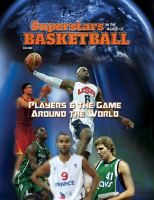

9
A Game That Br idged Di f f erences
Naismith got a job with the YMCA, which had the same ideas he did about sports.
The YMCA’s
philosophy
was that sports would not only strengthen the bodies of urban
kids, but that it would also help them to become better people. Naismith got a job at the
YMCA in Springfield, Massachusetts, ready to put his ideas into practice.
But he ran into problems. The players at the YMCA—young men in their late teens
and early twenties—were a rough bunch. They spent a lot of their time at the Y fighting
with each other. In the YMCA gymnasium, Naismith tried to channel the men’s restless-
ness through indoor soccer and lacrosse. However, these sports weren’t good for playing
inside four walls. The games broke down into fights. Players ended up injured, and the
walls and floors were damaged.
So Naismith decided to invent his own sport. He wanted no roughhousing in his gym—
but he did want a challenging sport that would take skill. He also wanted a game that
would allow players to
improvise
. The young men who came to the Y had too many rules
in their lives as it was; they needed a place where they could be free to solve their own
problems, where their individual intelligence and skill would have room to grow.
So Naismith jotted down some simple rules on a sheet of paper, and then he nailed
two peach baskets high on the walls of the gym. The first game was played with a soccer
ball and nine students on each team (because Naismith had eighteen students). A janitor
was convinced to climb a ladder to retrieve the ball each time someone made a basket.
Fortunately for the janitor, the first game ended with a score of 1–0.
By the time Naismith and his students had played the new game a few times, they
Make Connections
Several changes have been made since the early days of basketball. Naismith’s
players wore wool jerseys with long sleeves and long pants, while today, players
wear light jerseys so they can move more easily, with matching colors and individ-
ualized numbers so people can recognize them better. Originally, shots from the
f ield had to be two-handed. If a player fouled, then anyone on the opposing team
could shoot the free throw. Teams also could have any number of players (in 1892,
Cornell University had f ifty players on each side) before the number was f ixed at f ive. Despite
Naismith’s goals for basketball, many of the early games were a lot rougher than basketball is
today, often ending in f ights and arguments. Wire cages were put up around the court to protect
the audiences, and to prevent the audience from throwing bottles and other garbage onto the
court. Some referees even carried guns as a means of controlling the games!

















